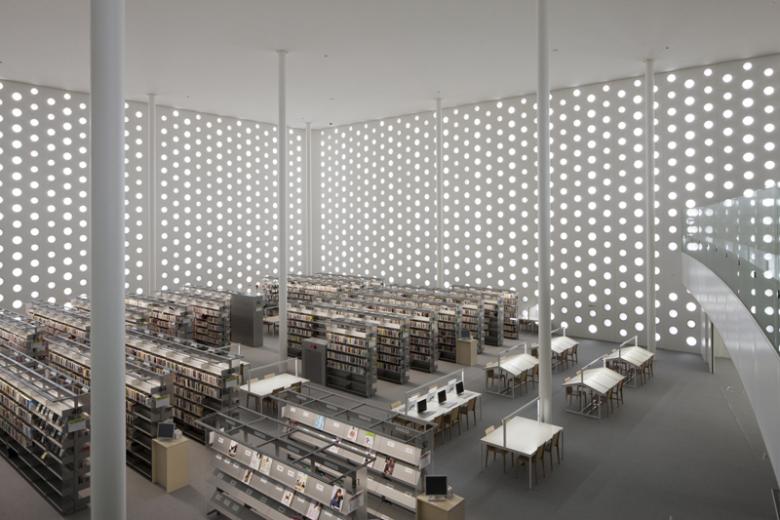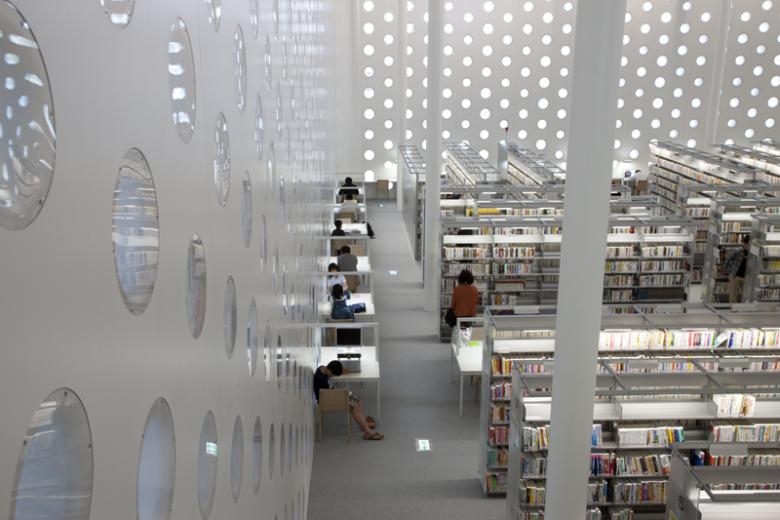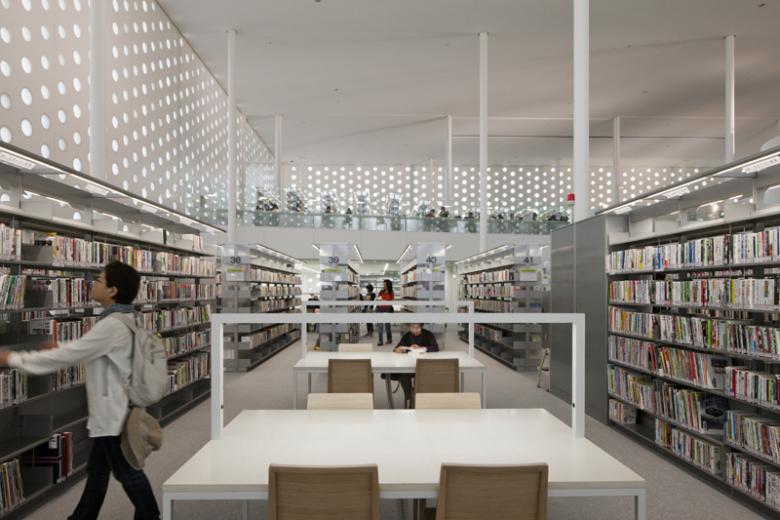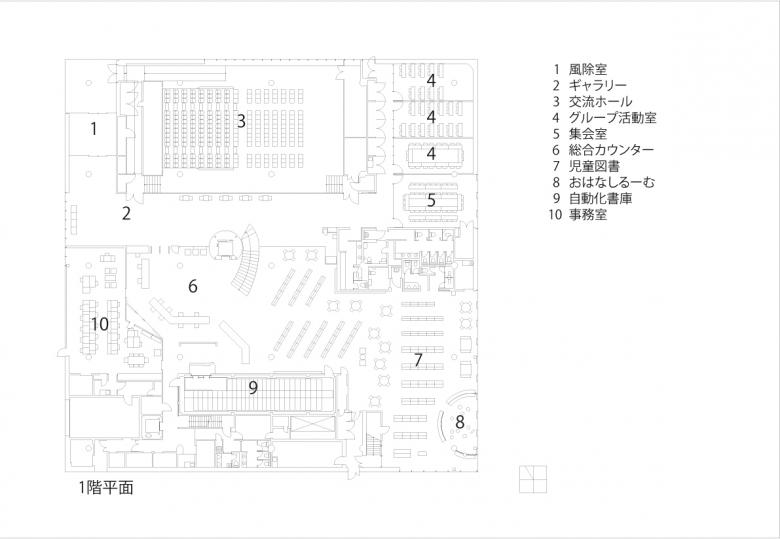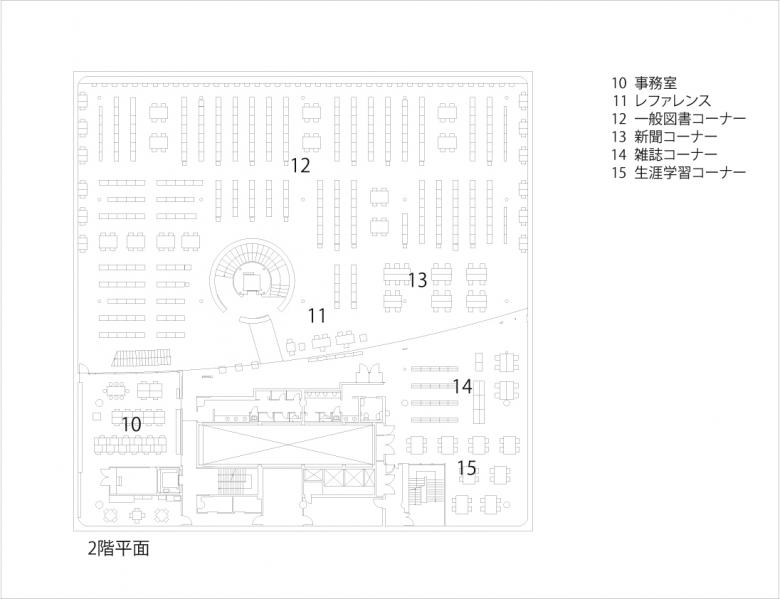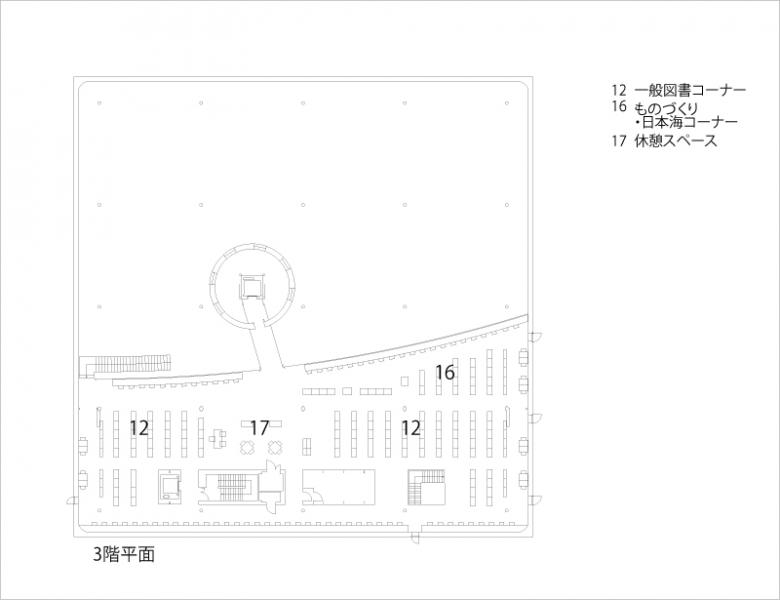Kanazawa Umimirai Library
Kanazawa Umimirai Library
With its complex of halls and meeting spaces, the Kanazawa Umimirai Library, designed by Coelecanth K&H, serves as the core of a new community in the castle district of Kanazawa. Twenty-five pillars support the 45-meter-square, 12-meter-high space, lending it a sense of presence fitting to a facility for storing books. At the same time, the soft light which filters through the round holes perforating the walls gives the library the quiet, calm feeling of a forest.
We asked Coelacanth K&H architects Hiroshi Horiba and Kazumi Kudo about the project.
Tell us about the basic concept behind the project.
The library is one of four in the city of Kanazawa, with about 400,000 books in its collection (270,000 in open stacks, including 45,000 children’s books, and another 130,000 in closed stacks), as well as halls, group activity rooms, meeting rooms and other community exchange facilities. We felt that providing a comfortable place for reading books was key in a public library. There’s no question that there’s a unique pleasure and richness to the experience of sitting down to read in a room filled with books, of being surrounded by the overwhelming presence of physical books. That’s something you just don’t get with convenient electronic reading materials. We proposed a simple space composed of a 45-meter-square, 12-meter-high room supported by 25 pillars and surrounded by four perforated walls, with no divisions between the reading areas and the open stacks. The sense of volume in this large space was our way of representing a "library-like" reading room.
How did you get the commission?
Our plan was chosen from those submitted in an open call for design proposals. The site was an irregular former factory lot cut off during the construction of the city’s outer loop road. The southern part of the city where it’s located experienced a growth in population after the prefectural office moved there, so new public facilities were needed. We proposed locating the building close to the road, both out of consideration for the nearby residential neighborhood and in order to increase its symbolic force. That freed up an open space on the lot that allowed us to give the reading room a better view and deepen the sense of unity between the exterior and interior areas.
What were the main design challenges you faced? Tell us how you solved any problems that arose.
In order to design a place for encountering books, we had to consider height, length, width, brightness, smell, acoustics, temperature, and even, in a region with cold snowy winters, the issue of moisture condensation. The main objects of our design work were the large volume of air, the natural light, and the moisture, temperature, and sound that those elements create. We were persuing a framework that would allow visitors to naturally sense the large air volume, while at the same time maintaining our basic concept for the space. We particularly struggled with how to bring in natural light. We performed a range of simulations involving the size, shape, number, and placement of windows, and finally built a 1/10 model to confirm our final decision.
How does this project fit into current architectural trends such as sustainable design, technology, etc?
Despite the size of the space, however, we were able to reduce energy costs associated with heating and cooling to one third of what’s normal for a building of similar size by incorporating radiant cooling systems and intermittent natural ventilation. The nature of boundaries between interior and exterior – in other words, the essential definition of architecture - is currently being questioned. This project presents the possibility that the value of a space itself can engender meaning.
Email Interview by Yuna Yagi
Kanazawa Umimirai Library
2011
Ishikawa
Architects
Hiroshi Horiba + Kazumi Kudo
Coelacanth K&H
Tokyo
Project Team
Tsukasa Watanabe
Haru Yoshimura
Ryunosuke Shirasaka
Structural Engineer
Masato Araya
Hirohide Tao / Structural Design Office OAK
Machinery Engineer
Takama Saburo
Kagaku Oyo Heating and Cooling Research Center
(Oversight: Koji Matsuyanagi / SE Planning)
Electrical Engineer
Takashi Oshima
Contractor
Toda Corporation
Kenroku Kensetsu
Takada Construction Joint Venture
Landscape Architect
Soichiro Tsukamoto /
Soichiro Tsukamoto Architecte de Paysages
(schematic design)
Lighting Designer
Lighting: Hironobu Kira
Shiho Owaki / Koizumi Lighting Technology
Furniture Design
Kazuko Fujie
Midori Nozaki
Kei Watanabe / Fujie Kazuko Atelier
Library Plan Adviser
Sadao Uematsu / University of Tsukuba
Acoustics Adviser
Hiroyoshi Fujii / University of Toyo
Computation Design
Yoshihiko Hamano / AALab
Site Area
11,763.43㎡
Building Area
2,311.91㎡
Total Floor Area
5,641.90㎡
Photos
Satoshi Asakawa

